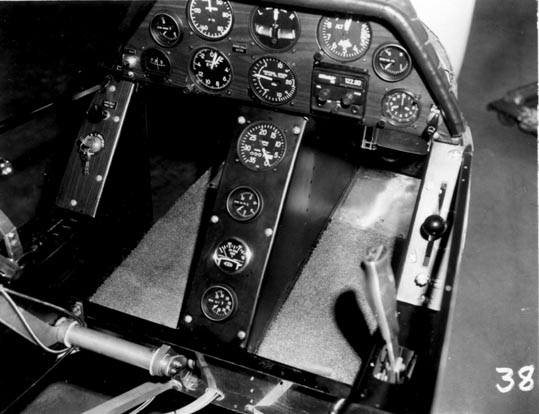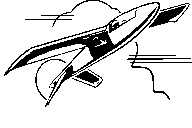









Canopy
The canopy is a shaded or clear, Plexiglasä
unit with excellent optical characteristics so that there is a minimum of
distortion to forward vision despite the very acute vision angle through it in
the forward direction. Two side
“opera” type windows permit the pilot to observe the main gear in the
extended position. The Plexiglasä
canopy can be fitted precisely to the fuselage through the use of patterns which
are included in the drawing set. The
canopy on the prototype opens to the left on a sealing piano hinge and is
restrained from opening too far with a restraint cable.
A low-drag installation is obtained by using a removable hex “T”
wrench through a hole in the canopy for the outside access handle.
The inside handle actuates two hooks which pull the canopy down snug with
an over-center motion of the handle to provide inside security and prevent
inadvertent canopy opening in flight. The
canopy frame is assembled with blind rivet construction.
The Plexiglasä
is held in the frame with RTV sealant and mechanical restraint in such a way as
to prevent inadvertent blow-out. Two
pins on the canopy frame guide and align the right edge of the canopy to assure
flush alignment on the outside at all times.
Cockpit
The cockpit of the Mini-IMP is entered by
merely stepping aboard over the edge, which is only 20 inches high, onto the
floorboard where it is possible to stand erect without having to stand on the
seat. A hand grip on top of the
instrument panel visor is sufficiently strong to permit you to lower yourself
into the foam and vinyl upholstered semi-reclining bucket seat. The fuselage is
26 inches wide at the pilot’s elbows which gives plenty of room inside even
for a very large person. Seating is
extremely comfortable with plenty of leg room for even very tall people, and the
seating is wide enough for pilots up to 250 pounds weight.
Permissible Center of Gravity travel is sufficient for even very large
pilots as well as very small individuals.

The primary flight control is located on the
structural angle that forms the right arm rest. The handle is slightly inclined to the left when in the
neutral (aileron) position. This
permits the pilot to easily rest his right hand against his leg in flight to
steady any inadvertent motion of the flight control.
The flight control system is a combination of rods for the ailerons and
ruddervator mixer with cables running to the tail surfaces from the mixing
system. The trim system permits instant trim adjustment and the trim handle
position provide indication. There
is no “feed-back” between the rudder pedals and the elevator motion of the
flight control as is so common with some “mixer” systems which are used for
“ruddervators” in some aircraft nor is there any “feed-back” from the
elevator trim system in the aileron motion of the flight control.
The rudder pedals are equipped with toe brakes and a parking brake pull
handle is located on the instrument panel to the right. The rudder pedals are
the “hanging” type which leaves the floor boards clear and prevents any
possibility of fouling the pedals with anything dropped on the floor.
The ignition switch and carburetor heat controls occupy the left hand
semi-panel. Engine instruments are
located on the center semi-panel between the pilot’s legs, with flight
instruments on the main panel ahead of the pilot.
The fuel shut off is located on the main bulkhead to the left behind the
pilot. The main bulkhead is equipped with a large removable access panel which
gives complete access to the magnetos and starter for any service or adjustment,
making access to the engine complete on all sides.
The cockpit of the Mini-IMP is fitted with a
specially designed semi-reclining fiberglass bucket seat, which is upholstered
with deep urethane foam and covered with a durable vinyl cover. The seat folds
forward for easy access to the baggage space behind it and is locked in the
seated position with two Camlocä
fasteners. The seat is fitted with
shoulder harness as well as the safety belt.
The shoulder harness ties directly to the wing attachments and engine
mount cluster so that there is no danger of the shoulder belts tearing out in an
emergency or crash landing
The instrument panel of the Mini-IMP is
large enough to accommodate up to 8 standard size (3 1/8” diameter)
instruments. Other panel
arrangements are possible. Vacuum
powered instruments are practical since it is easy to mount the driving venturi
aft of the cooling fan so that they are not outside and otherwise impair
performance. Radio antennae can be
installed inside the nose cone or the optional composite vertical fin.
The prototype radio installation exhibits excellent performance with the
internal antenna. Miniature instruments and radios now available would permit
easy installation of complete IFR capability if desired, although it should be
pointed out that the Mini-IMP was not originally designed for IFR type flying.
The cockpit is fitted with a fresh air vent
control on the left of the instrument panel.
The vent gets its air from the nosewheel area without external drag
producing openings. The rear of the
cockpit can be fitted with a sound blanket, which effectively shuts out engine
noise transmitted forward from the engine spaces aft of the rear cockpit
bulkhead. The Mini-IMP prototype
has not been fitted with a cabin heater. It
is anticipated that it would be necessary to include an electrically powered
blower in order to move warm air ahead into the cockpit area, and this
necessitates the installation of an electrical system with its attendant
complication and weight.
 Mini-IMP
Aircraft Company
Mini-IMP
Aircraft Company 